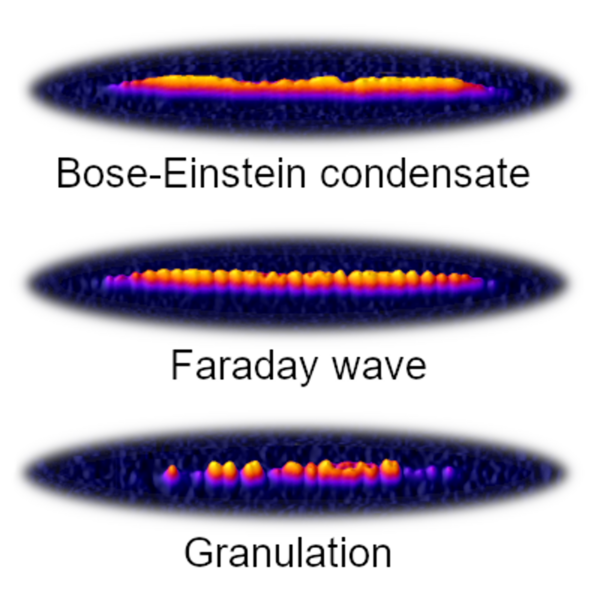MATERIALS SCIENCE AND CHEMISTRY
Granulation and Faraday Waves in Driven Quantum Systems
Principal Investigator:
Axel U. J. Lode(1) and Alexej I. Streltsov(2)
Affiliation:
(1)Technische Universität Wien, now: Institute of Physics, Albert-Ludwig University of Freiburg, (2) Institute of Physical Chemistry, Universität Heidelberg
Local Project ID:
MCTDHB
HPC Platform used:
Hazel Hen of HLRS
Date published:
Abstract
Granular matter is typically the result of random pattern formation in a solid, like breaking a glass or pulverizing a rock into pieces of variable sizes. Faraday waves are patterns that appear on a fluid that is perturbed by an external drive that oscillates in resonance. Faraday waves aren't random; in contrast to granular matter, these waves are regular, standing, periodic patterns, seen for instance in liquids in a vessel that is shaken. Surprisingly, granulation and Faraday waves can exist in quantum systems too and, even more surprisingly, they can be produced in the same quantum system: in a gas of trapped atoms cooled very close to absolute zero temperature. When the strength of interactions between atoms is modulated, a Faraday pattern is produced if the modulation is fast and weak, and a granular state is formed if the modulation is slow and strong.
Faraday waves
Faraday waves in a Bose-Einstein condensate (BEC), a quantum fluid of ultracold atoms (see upper image) are triggered by a “shaking” which is realized by modulating the strength of the interactions between atoms via an applied/external time-dependent magnetic field. This shaking results in the formation of a one-dimensional Faraday wave pattern, shown in the middle figure. This pattern emerges only when the frequency of modulation is tuned to near a collective mode resonance, i.e., for a small-amplitude drive at high frequencies.
Granulation
But, what happens at modulation frequencies that are far from resonance? The researchers discovered something startling and unpredicted: when the modulation frequency is far below a Faraday resonance, and the modulation is strong, the BEC breaks into “grains” of varying size, as shown in the lower image. The sizes of the grains are broadly distributed, and they persist for times even longer than the modulation time. Each realization of the experiment resulted in a different distribution of grains.
YouTube-Video! https://www.youtube.com/watch?v=h4zblhQz0K0&t=1s
Photos of quantum systems -- quantum snapshots
The experiments on granulation and Faraday waves in quantum systems were performed at Rice University, Houston, TX, USA, in a collaboration with scientists from Sao Carlos, Sao Paulo, Brazil. Their results consist of so-called single-shot images which are virtually photos of the produced quantum states.
For the same experimental parameters (i.e. identical preparation of the experiment), the pictures always look alike in the case of Faraday waves. The situation is different in the case of granulation: the granular quantum state results in every picture being different, even though the imaged quantum system was prepared in exactly the same way! This is an astonishing manifestation of the probabilistic nature of the quantum system and a hallmark of the so-called quantum correlations that rendered the theoretical modeling and understanding of the results difficult.
The direct simulation of the experimental observation of Faraday waves and granulation has been performed on the Hazel Hen Cray XC40 HPC system at the HLRS in Stuttgart. Without these large-scale simulations the interpretation of the observed quantum many-body effects would have been impossible.
Further reading:
MCTDHB theory
Phantom Vortices
MCTDHB software
MCTDH-X software
Scientific Contact:
Dr. Axel U. J. Lode
now: Institute of Physics
Albert-Ludwig University of Freiburg
Hermann-Herder-Strasse 3, D-79104 Freiburg (Germany)
e-mail: auj.lode@gmail.com
HLRS Project ID: MCTDHB
October 2019
